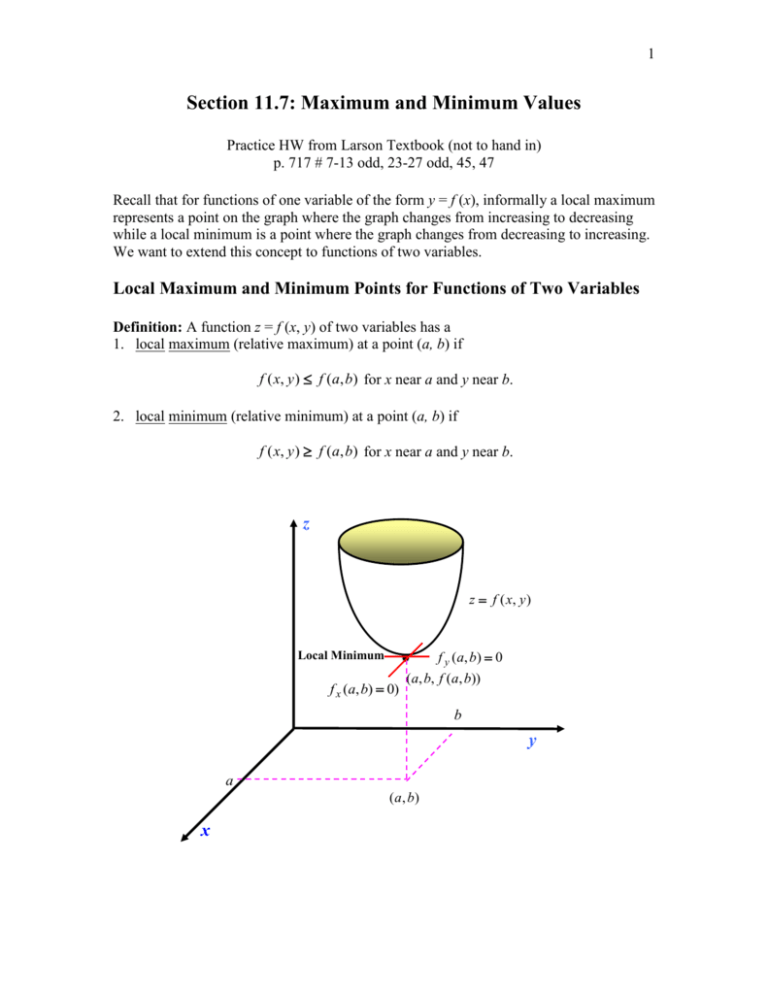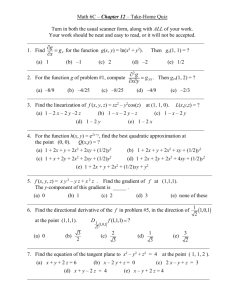Section11.7Larsonnot..
advertisement

1 Section 11.7: Maximum and Minimum Values Practice HW from Larson Textbook (not to hand in) p. 717 # 7-13 odd, 23-27 odd, 45, 47 Recall that for functions of one variable of the form y = f (x), informally a local maximum represents a point on the graph where the graph changes from increasing to decreasing while a local minimum is a point where the graph changes from decreasing to increasing. We want to extend this concept to functions of two variables. Local Maximum and Minimum Points for Functions of Two Variables Definition: A function z = f (x, y) of two variables has a 1. local maximum (relative maximum) at a point (a, b) if f ( x, y ) f (a, b) for x near a and y near b. 2. local minimum (relative minimum) at a point (a, b) if f ( x, y ) f (a, b) for x near a and y near b. z z f ( x, y ) f y ( a, b) 0 Local Minimum f x (a, b) 0) (a, b, f (a, b)) b y a (a, b) x 2 f x (a, b) 0) Local Maximum z f y ( a , b ) 0) (a, b, f (a, b)) z f ( x, y ) b y a (a, b) x At both the relative maximum and relative minimum points, the slope in the x direction at (a, b) is zero. That is, Slope of tangent of f at (a,b) = f x (a, b) 0 Similarly, in the y direction, Slope of tangent of f at (a,b) = f y (a, b) 0 This gives the following. First Derivative Test for a Function of Two Variables Is z = f (x, y) has either a local (relative) maximum or a local (relative) minimum at (x, y) = (a, b) , then f x (a, b) 0 and f y (a, b) 0 or f x (a, b) and f y (a, b) does not exist. 3 Notes 1. Local maximum and/or local minimum points may or may not give absolute maximum and/or minimum points. 2. The point (a, b) where f x (a, b) 0 and f y (a, b) 0 or f x (a, b) and f y (a, b) does not exist is called a critical point. Critical points only give candidates for local maximum and minimum points. For functions of two variables, there is an analog for the second derivative test using concavity for one variable functions. Second Derivative Test for Functions of Two Variables (D Test) Suppose f (x, y) is a function and (a, b) is a point where f x (a, b) 0 and f y (a, b) 0 Let D( x, y ) f xx (a, b) f yy (a, b) [ f xy (a, b)] 2 1. If D(a, b) 0 and f xx (a, b) 0 , then f has a local minimum at (a, b). 2. If D(a, b) 0 and f xx (a, b) 0 , then f has a local maximum at (a, b). 3. If D(a, b) 0 , then f has neither a local maximum or local minimum. The function f has a saddle point at (a, b). 4. If D(a, b) 0 , the test fails. Note: A point (a, b) is called a saddle point if f x (a, b) 0 and f y (a, b) 0 but the point is neither a local maximum or minimum point. The following graph is a plot of the function z f ( x, y ) which has a saddle point. 4 Example 1: Determine the local maximum, local minimum, and/or saddle points for the function f ( x, y) x 2 y 2 . Solution: █ 5 Example 2: Determine the local maximum, local minimum, and/or saddle points for the function f ( x, y) x 2 5 y 2 8x 10 y 13 . Solution: █ 6 The following represents the graph of f ( x, y) x 2 5 y 2 8x 10 y 13 where the local minimum of (-4, 1, -34) can be seen. 7 Example 3: Determine the local maximum, local minimum, and/or saddle points for the function f ( x, y) 18xy x 3 9 y 2 . Solution: 8 █ 9 The following represents the graph of f ( x, y) 18xy x 3 9 y 2 where the local maximum of (6, 6, 108) and saddle point of (0, 0, 0) can be seen. 10 Example 4: Determine the local maximum, local minimum, and/or saddle points for the function f ( x, y ) x cos y . Solution: We first compute the critical points by setting f x ( x, y ) cos y 0 f y ( x, y ) x sin y 0 For f x ( x, y) cos y 0 , y must be an odd multiple of y , , that is 2 5 3 3 5 , , , , , , 2 2 2 2 2 2 Compactly, this can be written as y (2n 1) , where n is a non-negative integer. If y 2 , sin y 0 . Thus , f y ( x, y ) x sin y 0 only when x = 0. 2 (2n 1) ) , where n is a non-negative integer. Thus, the critical points have the form (0, 2 Now, f xx ( x, y ) 0 , f yy ( x, y ) x cos y , and f xy ( x, y ) sin y . Thus, must be an odd multiple of D ( x, y ) f xx ( x, y ) f yy ( x, y ) [ f xy ( x, y )] 2 0 ( x cos y ) [ sin( y ) 2 ] 0 sin 2 y sin 2 y If y is an odd multiple of , sin y 1 or sin y 1 . In either case, sin 2 y (1) 2 1. Thus, D(0, (2n 1) (2n 1) ) sin 2 [1] 2 1 0 2 2 Thus, each critical point will be a saddle point. For odd multiples of , cos y 0 . Thus, (2n 1) (2n 1) z f ( x, y ) x cos y , z f (0, ) 0 cos 0 0 0 . This, the 2 2 (2n 1) ,0) saddle points occur at the points (0, 2 (continued on the next page) 11 The following shows a graph of z f ( x, y ) x cos y █ Note: It is important to note that for a function of two variables z f ( x, y ) , local maximum and minimum points are not always guaranteed to give absolute maximum and minimum points. However, if the region over which z f ( x, y ) is defined is closed and bounded, it is possible to obtain the absolute maximum and minimum points.








